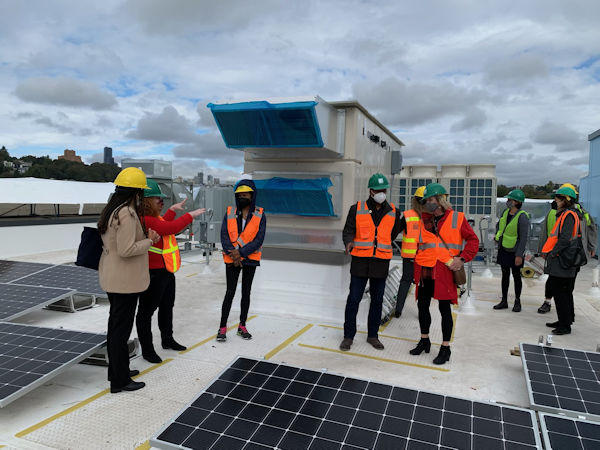SEJournal Online is the digital news magazine of the Society of Environmental Journalists. Learn more about SEJournal Online, including submission, subscription and advertising information.
 |
| White House Council on Environmental Quality Chair Brenda Mallory (above, third from left) visited Seattle last fall to learn about the city's energy efficiency and housing access initiatives. CEQ has developed a climate and economic justice screening tool to guide allocation of environmental and clean energy dollars. Photo: @BrendaMallory46. Click to enlarge. |
Reporter’s Toolbox: Environmental Justice Beat Gets Boost From New Database
By Joseph A. Davis
Reporting on environmental justice is getting easier, if not yet convenient. A climate and economic justice screening tool recently released by the White House offers journalists a handy new reference.
The White House tool is now out in beta — online and fully usable. It’s a great time to try it out, because the developers are collecting feedback from users until April 25, 2022.
By the way, if you are an environmental journalist data geek, you probably already know about a related data tool, the U.S. Environmental Protection Agency’s EJScreen (which SEJournal’s TipSheet has previously written about).
There are important differences between the two tools, and both journalists and environmental justice may benefit from them.
Targeting federal environmental aid
It may help to know some of the backstory.
Environmental justice is a top goal of the Biden administration, and Biden made that clear with an executive order his first week in office.
One framework for Biden’s environmental justice plan, called Justice40, aims to deliver 40 percent of federal environmental aid dollars to disadvantaged communities.
It’s a modern take on old-school distributive politics, billed as a whole-of-government effort, but with its nerve center at the White House Council on Environmental Quality, or CEQ, chaired by Brenda Mallory.
It’s that team that developed the climate and economic justice screening tool. It is meant to guide the allocation of environmental and clean energy dollars.
Check out more on the screening tool, access the main search portal and read a thorough description of methodology.
The data landscape
The tool’s main unit of mapping is the census tract — one of the smallest units available. That is good because it is a standardized basis for all kinds of federal data, demographic and otherwise.
Much has been made already
of the fact that the new screening
tool does not use data on race.
Much has been made (may require subscription) already of the fact that the new screening tool does not use data on race. Intuitively, that is surprising, because decades of data and research have confirmed the strong connection between race and environmental harms.
The reason for this, CEQ’s Mallory has explained, is the hope of heading off or disarming lawsuits over whether race should be a basis for distributing federal funds.
For journalists, this may not matter. You can put the racial and other data back in using any one of several data sources.
Using the data smartly
One place to get racial data is the Census Bureau, which thoughtfully supplies it by census tract. EPA’s EJScreen will also give you racial demographics by census tract, although it focuses mostly on the user-friendly address or ZIP code.
But what may matter most for journalism about environmental justice is all the other data categories.
Both EPA’s EJScreen and CEQ’s screening tool are very rich in demographic data and also indicators relevant to environmental health. But they are somewhat different. And that may be a good reason to explore CEQ’s new screening tool now.
(Incidentally, you may want to look at ProPublica’s Sacrifice Zones tool on toxic hotspots in the same context.)
Among the special strengths of the CEQ screening tool are data on clean transit, clean water and wastewater infrastructure, median home value, asthma and life expectancy, agricultural loss rate, building loss rate (from weather disasters), energy cost burden and proximity to a range of hazardous waste facilities.
[Editor’s Note: For more on environmental justice issues, explore our related “Topics on the Beat” page, as well as a Backgrounder on the Biden administration's struggle with environmental justice concerns in 2022 and a Society of Environmental Journalists’ webinar on the complexities of environmental justice reporting. Plus, get daily weekday headlines on environmental justice stories from EJToday and our @EJTodayNews Twitter feed.]
Joseph A. Davis is a freelance writer/editor in Washington, D.C. who has been writing about the environment since 1976. He writes SEJournal Online's TipSheet, Reporter's Toolbox and Issue Backgrounder, and curates SEJ's weekday news headlines service EJToday and @EJTodayNews. Davis also directs SEJ's Freedom of Information Project and writes the WatchDog opinion column.
* From the weekly news magazine SEJournal Online, Vol. 7, No. 10. Content from each new issue of SEJournal Online is available to the public via the SEJournal Online main page. Subscribe to the e-newsletter here. And see past issues of the SEJournal archived here.













 Advertisement
Advertisement 



